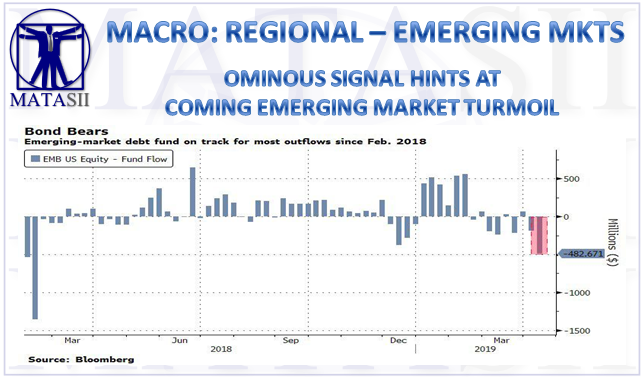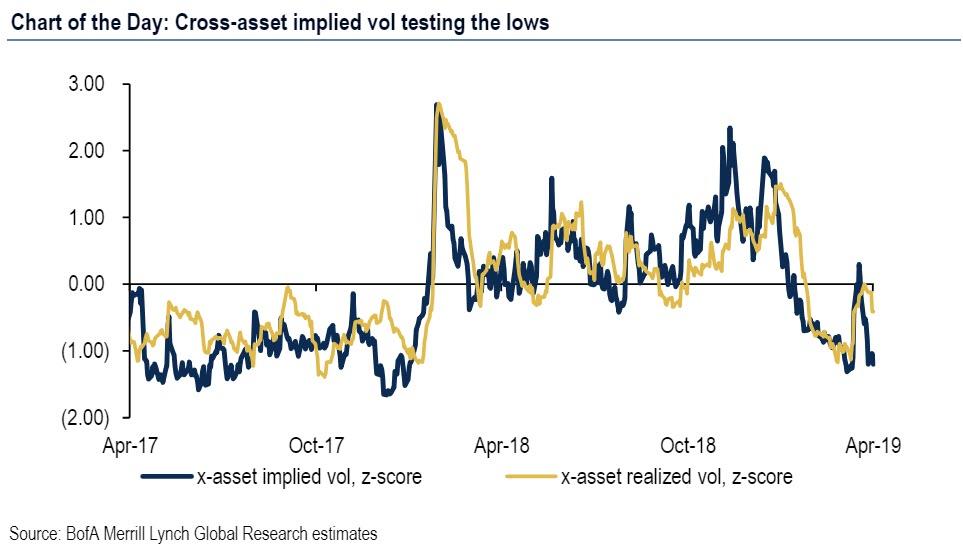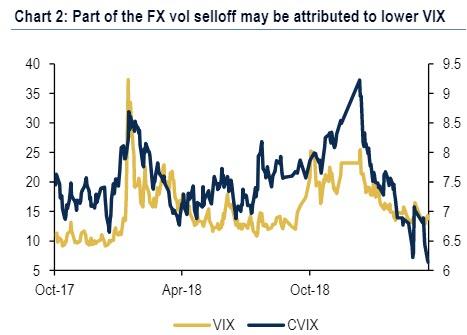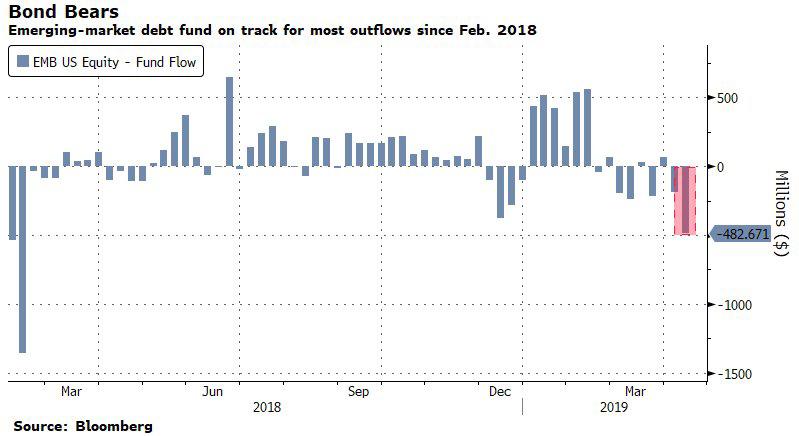OMINOUS SIGNAL HINTS AT COMING EMERGING MARKET TURMOIL
Keep an eye on investor flows in "less loved" assets such as EM bonds, which are now the best canary in the equity market coalmine
- Persistent political uncertainty has shackled directional traders and kept some corporates from investing overseas and thereby reducing both speculative as well as transactional FX flows.
- A bigger part of the FX vol weakness may be attributed to a falling VIX.
- This crowded short vol positioning across assets suggests the next shock could lead to a vol spike, magnified by elevated cross-asset correlations according to BofA.
- Investors are inexplicably pulling more money from the biggest emerging-market bond ETF than at any time in the past year - even more than during the depth of the December mini-bear market.
- It may well be the case that the excess liquidity that flooded the market at the start of 2019 is starting to shrink rapidly, and as a result investors are reeling in those bets that have underperformed. And while this does not mean that an equity market crash is imminent, should the liquidity crunch continue - for whatever reason - and investors are forced to shift their selling from EM bonds to DM stocks, it's only a matter of time before this "ominous signal" spreads to riskier asset classes.
Here is an analysis that lays out the above points:
In a world drowning in complacency following the abrupt dovish reversal by virtually all central banks, investors have been starving for clues about potential market inflection points. Indeed, in the first quarter we saw cross-asset vols testing lows not seen since the record low days of 2017, even though as BofA notes, realized vols have been "more constructive". And while, investors sold volatility across markets at already cheap levels to improve yield, doing so exposed them to highly asymmetric risks according to BofA FX strategist Vadim Iaralov.
Meanwhile, persistent political uncertainty has shackled directional traders and kept some corporates from investing overseas and thereby reducing both speculative as well as transactional FX flows. However, a bigger part of the FX vol weakness may be attributed to a falling VIX. Indeed, CFTC positioning data show a significant build-up of speculative VIX future shorts, which has coincided with falling FX vols. As a percentage of the open interest, VIX shorts are exceeding levels prior to major de-risking episodes in January and October 2018.
But is a shock coming? That of course, is the $64K question, and by at least one measure, despite the prevailing market calm, some traders are convinced that a shock is imminent and are yanking their money.
As Bloomberg shows in the chart below, even with the S&P back near all time highs, and with global stocks at 6 month highs, investors are inexplicably pulling more money from the biggest emerging-market bond ETF than at any time in the past year - even more than during the depth of the December mini-bear market.
The $16.5 billion J.P. Morgan Emerging Markets Bond ETF, the biggest ETF dedicated to EM debt, is heading to its worst week of outflows since February 2018, when the so-called volmageddon wrecked vol shorts and crushed EM longs. And while the catalyst is still unknown, the signal is there as investors have pulled $482 million from the EMB fund.
While some of Wall Street's marquee firms such as Goldman and T. Rowe Price continue to push clients in emerging markets (as they themselves offload their EM exposure), others are growing skeptical that the dovish Fed and the "weaker dollar" (which it not only not weaker, but is near its highest level since early 2017, will weaken as much as expected to give global bonds a boost.
Is this a notable inflection point and should it be taken seriously? Considering that developing-nation bonds have underperformed stocks this year after posting a smaller slide in last year’s selloff, it may well be the case that the excess liquidity that flooded the market at the start of 2019 is starting to shrink rapidly, and as a result investors are reeling in those bets that have underperformed. And while this does not mean that an equity market crash is imminent, should the liquidity crunch continue - for whatever reason - and investors are forced to shift their selling from EM bonds to DM stocks, it's only a matter of time before this "ominous signal" spreads to riskier asset classes.
But going back to the EM space for now, "the outlook for EM is now neutral going forward,” said Mohit Bajaj, director of ETFs at WallachBeth Capital. "The dollar hasn’t sold off as much as people expected it to, so part of it could just be profit taking." Bajaj added that money moving out of EMB could be going to longer duration U.S. debt ETFs or equity funds, which have outperformed recently; and while he is right, it is only a matter of time before investor disappointment with the recent fizzle in the global equity rally turns into outright selling, and the next leg lower in risk assets begins. Until then, keep an eye on investor flows in "less loved" assets such as EM bonds, which are now the best canary in the equity market coalmine.
[SITE INDEX -- MACRO: REGIONAL - EMERGING MARKETS]
READERS REFERENCE (SUBSCRIBERS-RESEARCH & PUBLIC ACCESS )
MACRO: REGIONAL - EMERGING MARKETS
MATASII RESEARCH ANALYSIS & SYNTHESIS WAS ABSTRACTED FROM:
INITIAL SOURCE: 04-11-19 - - "Ominous Signal Hints At Coming Emerging Market Turmoil"
FAIR USE NOTICE This site contains copyrighted material the use of which has not always been specifically authorized by the copyright owner. We are making such material available in our efforts to advance understanding of environmental, political, human rights, economic, democracy, scientific, and social justice issues, etc. We believe this constitutes a 'fair use' of any such copyrighted material as provided for in section 107 of the US Copyright Law. In accordance with Title 17 U.S.C. Section 107, the material on this site is distributed without profit to those who have expressed a prior interest in receiving the included information for research and educational purposes. If you wish to use copyrighted material from this site for purposes of your own that go beyond 'fair use', you must obtain permission from the copyright owner.
NOTICE Information on these pages contains forward-looking statements that involve risks and uncertainties. Markets and instruments profiled on this page are for informational purposes only and should not in any way come across as a recommendation to buy or sell in these assets. You should do your own thorough research before making any investment decisions. MATASII.com does not in any way guarantee that this information is free from mistakes, errors, or material misstatements. It also does not guarantee that this information is of a timely nature. Investing in Open Markets involves a great deal of risk, including the loss of all or a portion of your investment, as well as emotional distress. All risks, losses and costs associated with investing, including total loss of principal, are your responsibility.




